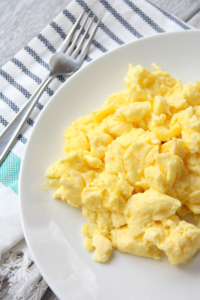
The Great Scrambled Egg Debate
A Simple Dish, A Complex Discussion
Making scrambled eggs seems easy, yet it sparks endless debate. The big question is: should you add milk? My mother-in-law insists it makes the eggs creamier and tastier. In contrast, I believe milk ruins their flavor and texture. Who’s right?
The Case for Adding Milk
Creamier Texture
Many cooks swear by adding milk for a creamier texture. The extra moisture creates softer, silkier curds. If you love a light, airy scramble, this method might be for you.
Balanced Flavor
Milk can tone down the eggs’ richness. While eggs have a rich taste, milk adds a mild flavor that balances it out. Some even notice a slight sweetness, especially with full-fat dairy.
Increased Volume
Adding milk is a clever way to stretch the servings. It makes it seem like you have more eggs without cracking extra. This trick is handy when cooking for a crowd.
The Case Against Adding Milk
Diluted Flavor
Purists argue that milk dilutes the eggs’ unique flavor. Instead of enhancing the taste, it can overshadow it, leaving a blander dish.
Texture Issues
While milk can add creaminess, it can also cause texture problems. Overcooked eggs may turn rubbery with extra liquid, resulting in dry, tough curds. The added moisture makes it harder to control cooking, leading to uneven results.
Unnecessary Addition
Some cooks believe high-quality eggs are rich enough alone. They argue that the best scrambled eggs need only eggs, salt, and butter, allowing the natural flavor to shine.
Alternatives to Milk
If you want to enhance your scrambled eggs without milk, consider these options:
Cream or Half-and-Half
For a richer scramble, try cream or half-and-half. These options add fat for a silkier texture without diluting flavor.
Butter
Adding butter while whisking the eggs enriches flavor and creates a smooth texture as it melts during cooking.
Cheese
Incorporate cheese like cheddar or feta for added creaminess and flavor. Cheese brings a delicious depth while contributing to a melty texture.
How to Make Scrambled Eggs Without Milk
Whisk Well
For fluffy eggs, whisk thoroughly to incorporate air. This aeration achieves a light texture without milk.
Use Low Heat
Cooking over low heat prevents rubbery eggs. This method allows soft curds to form without drying out.
Add Butter or Oil
Melt a tablespoon of butter or oil in your pan before adding eggs. This step prevents sticking and adds creaminess.
Stir Gently
Gently stir the eggs as they cook to form tender curds. Avoid over-stirring, which leads to denser pieces.
The Verdict: Who’s Right?
Ultimately, adding milk to scrambled eggs comes down to personal preference. Some enjoy the creaminess milk provides, while others prefer the pure taste of eggs. There’s no single “right” way—what matters is your enjoyment.
If you favor a milder scramble, adding milk might suit you. However, if you appreciate the rich, authentic taste of eggs, consider skipping it. Experiment with both methods to find your favorite.
Conclusion
The milk debate in scrambled eggs illustrates how simple topics can inspire passionate opinions. The best scrambled eggs are those that bring you joy at the table.
Whether you’re team milk or team no milk, embrace cooking’s flexibility. Experiment, adjust, and make your scrambled eggs just the way you like them. After all, the only rule that truly matters is your own taste.